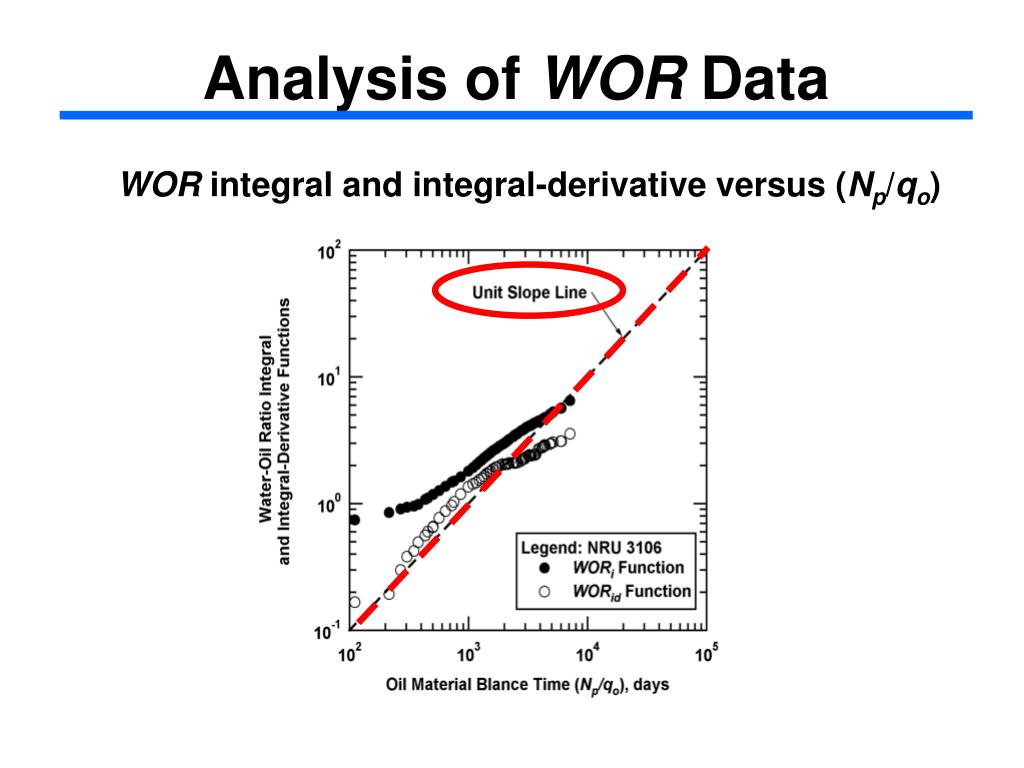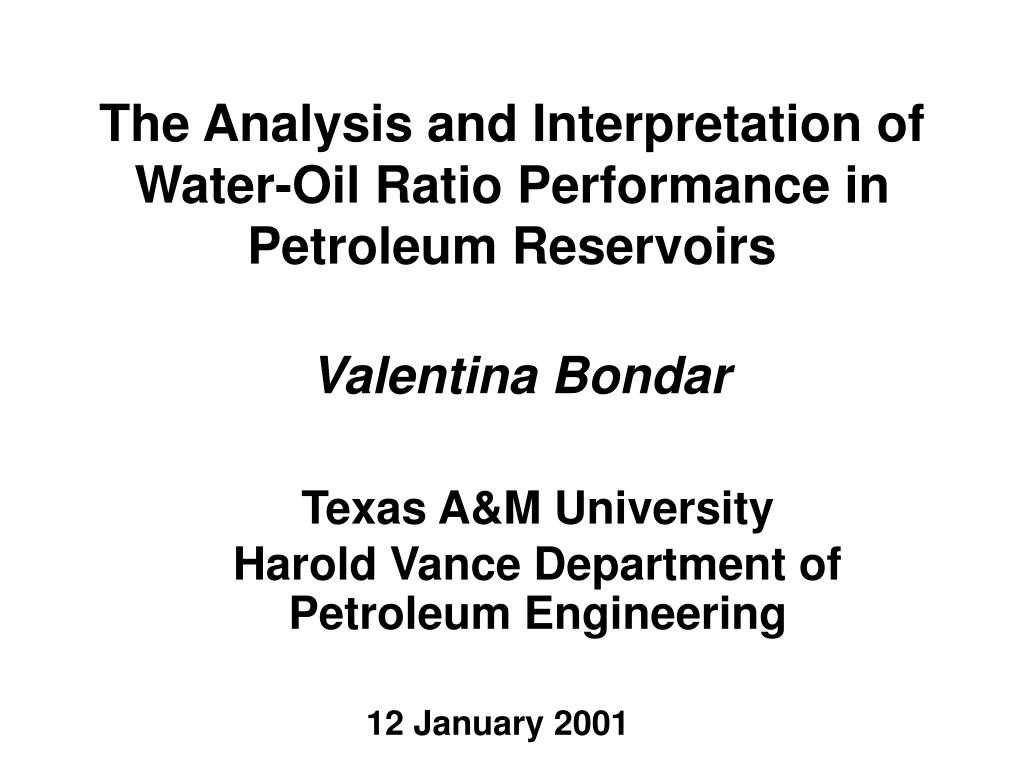
(PDF) Analysis and Interpretation of WaterOil Ratio in Waterfloods
This work presents the development and validation of a multivariate relation for the behavior of the water-oil-ratio (WOR) and/or water cut (fw) functions and develops a rigorous model for the simultaneous flow of oil and water during pseudosteady-state flow conditions. pe.tamu.edu Save to Library Create Alert Cite Figures from this paper figure 1

Improvements of wateroil ratio between nontreated waterflooding and
Water-oil ratio forecasting is an empirical analysis method; there is no formal model or equations. Plots of both water-oil ratio and water-oil ratio +1 are used in forecasting, and the plots are typically semi-log with cumulative oil production as the x-axis. Water-oil ratio, water-oil ratio +1, and water cut are defined below:

Effect of the wateroil volume ratio on (a) porosity and bending
Abstract This work presents the development and validation of a multi- variate relation for the behavior of the water-oil-ratio (WOR) and/or water cut (fw) functions. This new model incorporates the reservoir and fluid properties for both phases (oil and wa- ter) and is based on the assumption of pseudosteady-state flow conditions.

Wateroil ratios for different processes. Download Scientific Diagram
Everything You Love On eBay. Check Out Great Products On eBay. Check Out Ratio Water On eBay. Find It On eBay.

[PDF] Analysis and Interpretation of WaterOilRatio Performance
Recently, Chan (Chan, K.S.: "Water Control Diagnostic Plots," paper SPE 30775 presented at the 1995 SPE Annual Technical Conference and Exhibition, Dallas, 22-25 October) postulated that a.

[PDF] Analysis and Interpretation of WaterOilRatio Performance
The following steps outline how to calculate the Oil Water Ratio. First, determine the percentage volume of water (%). Next, determine the percentage volume of oil (%). Next, gather the formula from above = OWR = O/W. Finally, calculate the Oil Water Ratio. After inserting the variables and calculating the result, check your answer with the.

[PDF] Analysis and Interpretation of WaterOilRatio Performance
Ratio of the volume percent oil to the volume percent water in an oil mud, where each is a percent of the total liquid in the mud. OWR is calculated directly from the retort analysis of an oil mud. For example, if a mud contains 60 vol% oil and 18 vol% water, the oil percentage is [60/(60 + 18)]100 = 77% and the water percent is [18/(60 +18.

[PDF] Analysis and Interpretation of WaterOilRatio Performance
In terms of Waterdrive decline analysis, the Log (Water Oil Ratio) v's Cumulative Oil Production (or Np) to predict oil recoveries for water oil ratios (WOR) greater than 1 or watercut greater than 50% is commonplace. Therefore we have developed a simple routine to permit low, mid and high trend decline analysis of Log (WOR) v's Np relationships.

PPT The Analysis and Interpretation of WaterOil Ratio Performance in
Oil Ratio The GOR is defined as the volume ratio of gas and liquid phase obtained by taking petroleum from one equilibrium pressure and temperature, in the reservoir, to another, at the surface, via a precisely defined path. From: Elements of Petroleum Geology (Fourth Edition), 2023 Add to Mendeley About this page Black Oils Ahmed El-Banbi,.

PPT The Analysis and Interpretation of WaterOil Ratio Performance in
The oil/water ratio is 75/25. Example 1: Increase the oil/water ratio to 80/20: In 100 bbl of this mud, there are 68 bbl of liquid (oil plus water). To increase the oil/water ratio, add oil. The total liquid volume will be increased by the volume of the oil added, but the water volume will not change.

WaterOil Ratio by region Download Scientific Diagram
The principal reason for waterflooding an oil reservoir is to increase the oil-production rate and, ultimately, the oil recovery. This is accomplished by "voidage replacement"—injection of water to increase the reservoir pressure to its initial level and maintain it near that pressure.

PPT The Analysis and Interpretation of WaterOil Ratio Performance in
The water-oil ratio have an important impact on the structural properties of the samples. • Catalyst has the highest activity when water-oil ratio is 20. • The degradation ratio and the rate constant of RhB reach to 97.69% and 0.03253 min −1 in 100 min severally. • Because having small size structure, the largest specific surface area and so on.

Figure 1 from Analysis and Interpretation of WaterOilRatio
In fact, in certain mature regions in North America and the Middle East, the water to oil ratio can be as high as 10 to 14 [2, 3]. According to these statistics, oil companies could turn their.

PPT The Analysis and Interpretation of WaterOil Ratio Performance in
Analysis and Interpretation of Water/Oil Ratio in Waterfloods | SPE Journal | OnePetro Volume 4, Issue 04 Previous Article Journal Paper | December 01 1999 Analysis and Interpretation of Water/Oil Ratio in Waterfloods Y. C. Yortsos; Youngmin Choi; Zhengming Yang; P. C. Shah SPE J. 4 (04): 413-424. Paper Number: SPE-59477-PA

Variation of flow rate with water/oil ratio for flow rate of (34 l/min
where WOR is water-oil ratio; N p is the cumulative oil production, 10 4 t.. Equation () shows a linear relationship between water-oil ratio (WOR) and cumulative oil production (N p) under the semi-log coordinate.The method of linear segment extrapolation can be used to determine the ultimate recovery and recoverable reserves (Shuhua 2001).

[PDF] Analysis and Interpretation of WaterOilRatio Performance
Field wells cumulative oil production and water cut values are given in the Table.1including abandoned ones and producing with water-cuts of 98% or greater, at or near their economic limit. [16]. 5. FANALYSIS OF WATER-OIL-RATIO PERFORMANCE. Natural water drive is the most common mechanisms in oil reservoirs.